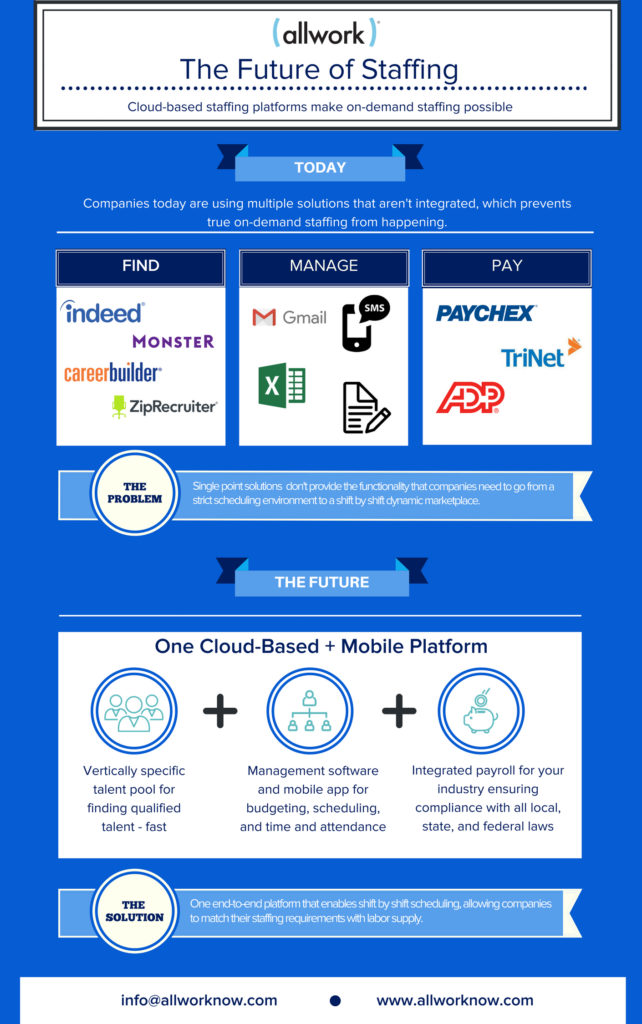The Future of Staffing: Cloud-Based Staffing Platforms Make On-Demand Staffing Possible
Many companies today are using multiple solutions for their staffing needs that aren’t integrated with each other. From paper schedules to excel spreadsheets, some are still relying on out-dated forms of management for their staffing solutions. This lack of technology prevents any kind of true on-demand staffing from happening. If managers need to use one resource for finding top talent, one for managing their budgets, one for scheduling talent and yet another for paying their talent, there is no way that efficient and timely staffing can happen.
The need to streamline and optimize staffing processes has reached a critical level with the shift of the workforce to a more flexible, on-demand model. According to a recent Workforce HR Report, 70% of managers are already utilizing flexible or contingent talent, including freelancers, temp, and agency workers, while HR managers anticipate that work done by contingents will increase by 179% in the next 10 years. It’s more important than ever for companies to transform their scheduling experience in order to adapt to this changing workforce.
On-demand staffing is inevitable:
- 40% of the US workforce freelancing by 2020.
- The shortage of hourly workers is becoming acute.
- Workers now value flexibility over income.
- Staffing is the last opportunity for cost savings in many industries.

Matching employees with the shifts they want and employers with the staffing they need is not possible as long as solutions like rigid rosters and paper schedules are the chosen methods for scheduling and managing. All of the single point solutions at a company’s disposal today don’t provide the functionality they need to go from a strict schedule environment to a shift-by-shift dynamic marketplace. But technology is changing that, and the right platform can drive benefits on both sides of the equation.

It’s clear that in order to optimize their staffing process, companies need to move to an on-demand staffing model. To do so, they need one cloud-based platform that will provide them with all of the resources they need in one place. By being able to tap into a vertically specific talent pool, hiring managers can find qualified talent fast while management software gives them the ability to schedule talent on-demand, manage their budgets, and process payroll — all in the same place.
One end-to-end platform is the key for companies to match their staffing requirements with their labor supply. In doing so, they’ll be able to optimize their workforce and save both time and money by reducing overscheduling and time spent by upper management on administrative tasks.
Glenn Laumeister-
Glenn Laumeister is CEO of AllWork.
- Published in Networking, Technology
Are You Liable for Employees Who Work From Home?
Letting employees work from home has definite value for small business owners and their employees. Cutting down on office space overheads and increasing employee productivity are two definite pros. However, there are potential cons such as employer liability that must be considered before you race headfirst into the telecommuting crowd.

Before you begin to support employees that wish to work from home, it is advisable to consider your legal obligations as their employer along with more specific business challenges such as communication and organizational culture.
Workplace Safety
The Occupational Safety and Health Administration (OSHA) directs employers to maintain a safe working environment and covers home-based workers with the same worker’s compensation rights as those working from the employer’s place of business.
Workers placed from a temporary agency are covered by slightly different laws and usually the responsibility for carrying workers’ compensation coverage falls to the staffing agency. However, on occasion, this can be negotiated on a per-contract basis between the host employer and agency.
Recent cases for worker’s compensation have demonstrated that no distinction is made between home-workers and those working from an employer’s place of business in terms of workers’ compensation and an employer’s liability. The key elements of such claims include showing an accident was work-related and that the injury sustained was a result of the accident. There is no requirement to prove the employer was responsible for the injury or accident, only that it was work related.
PREMIUM CONTENT: Building an Effective Staffing Website
As one work injury lawyer in Philadelphia states, an employer must provide workers compensation for their staff. Otherwise, they’re breaking the law. Most injuries that occur due to a work-related condition will be covered by a workers compensation plan.
Similar guidance is also relevant to injuries sustained by clients who have visited an employee at their home office. If a client trips and falls, injuring themselves or damaging any equipment such as a laptop, phone, or tablet, the employer may be liable for the injury and/or damage to property.
Public liability insurance may cover employers along with direct and temporary staff in these circumstances. It is advisable to check with insurers that your policy applies to home offices as well as the main place of work.
How to Protect Telecommuters and Your Business
In cases where employees telecommute, the employee’s home becomes the place of work. Given this, there are several actions and protocols small business owners should put in place to ensure the safety of their employees and their business.

Perform a safety survey – Regardless of where an employee is working from, they should comply with the business’ general health and safety policies. As part of this, before employees commence working at home, a full safety check of their designated work area should be carried out by them or you. In cases where agency staff are working from home – and the host employer and agency share joint responsibility for the remote worker – an agreement should be reached that shows due care. This ensures the employees’ workplace is safe for the tasks they are to perform on behalf of your business.Ergonomically designed furniture, adequate lighting and ventilation, smoke detectors and fire extinguishers should all be checked for and put in place. Potential dangers such as exposed extension leads and other trip hazards should be removed or mitigated. Safety surveys should be kept on file along with photographs of the area the employee intends to work from.
Homeowner’s or renter’s insurance – Employees should have up to date insurance for their intended place of work. Ensure telecommuting employees provide copies of their home or renters insurance papers and file these with the completed safety survey.
Digital security – All files stored in the cloud or on remote servers along with any hardware employees are using to work from home should be fully protected from unauthorized access. Secure connections should be set up by an IT professional to reduce any opportunity for hacking into company files. IT hardware and software provided by the employer should be for work-related use only and never used by anyone other than the delegated staff.
Update your own insurance – Ensure your business insurance covers remote workers as well as office-based employees. If you find there is a gap in your business insurance, update the policy for additional coverage before you allow employees to work from home. In some cases, it may even be necessary to take out additional management liability insurance.
Once the above tasks have been carried out, establish a work-at-home policy with clear guidelines to prevent misunderstandings between you and remote workers. Regular communication and the emphasis that remote work is a privilege should be part of any work-at-home policy. When all necessary legal and business procedures are in place, you are free to begin enjoying the benefits that remote workers can bring to your business.
Source- thestaffingstream
Author: Rae Steinbach
Rae Steinbach is a graduate of Tufts University with a combined International Relations and Chinese degree. After living and working abroad in China, she returned to NYC to pursue her career and continue curating quality content.
- Published in Networking, Technology



